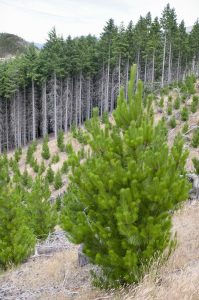Committing to the Preservation of New Zealand's Radiata Pine
Pinepac has made substantial investments and remains deeply committed to the Radiata Pine industry in New Zealand. With three company forests strategically located within a 50km radius of our processing plants in Kumeu and Whenuapai, covering a combined gross area of approximately 1,150ha (2,841 acres) and boasting over 800ha (2,000 acres) of planted area. Since 1993, we've planted over 1 million seedlings in these regions.
Our dedication to preserving nature is paramount as we strive to safeguard this vital resource for future generations. We adhere to strict forest management practices, ensuring the replanting of harvested areas within one year to initiate another tree crop cycle, spanning up to 30 years. For every tree harvested, we pledge to plant at least three saplings, nurturing them patiently over three decades before they are deemed ready for production. Typically, Radiata Pine trees are harvested at around 28 to 30 years of age, having contributed up to 28 cubic meters per hectare per year of solid wood fiber and sequestered approximately 800 tonnes of carbon dioxide during their rapid growth. Each harvested tree can yield up to 95% of its average volume of 2.41m3 as recoverable wood fiber.
Introduced to New Zealand in the 1850s for shelterbelts, Radiata Pine now dominates over 90% of the country's plantation forests, underscoring its versatility and adaptability. Pinepac remains steadfast in its pursuit of self-sufficiency in Radiata Pine cultivation, catering to the Whenuapai sawmill and Kumeu post and pole plant.
Harvesting Methods
While chainsaws are primarily employed for harvesting operations, some mechanical harvesting is conducted for small trees designated for pulpwood and sawlogs, where terrain permits. Rubber-tyred skidders and loaders facilitate the hauling and loading of logs for transportation to our processing plants. Manual harvesting is limited to steep slopes and thinning operations.

